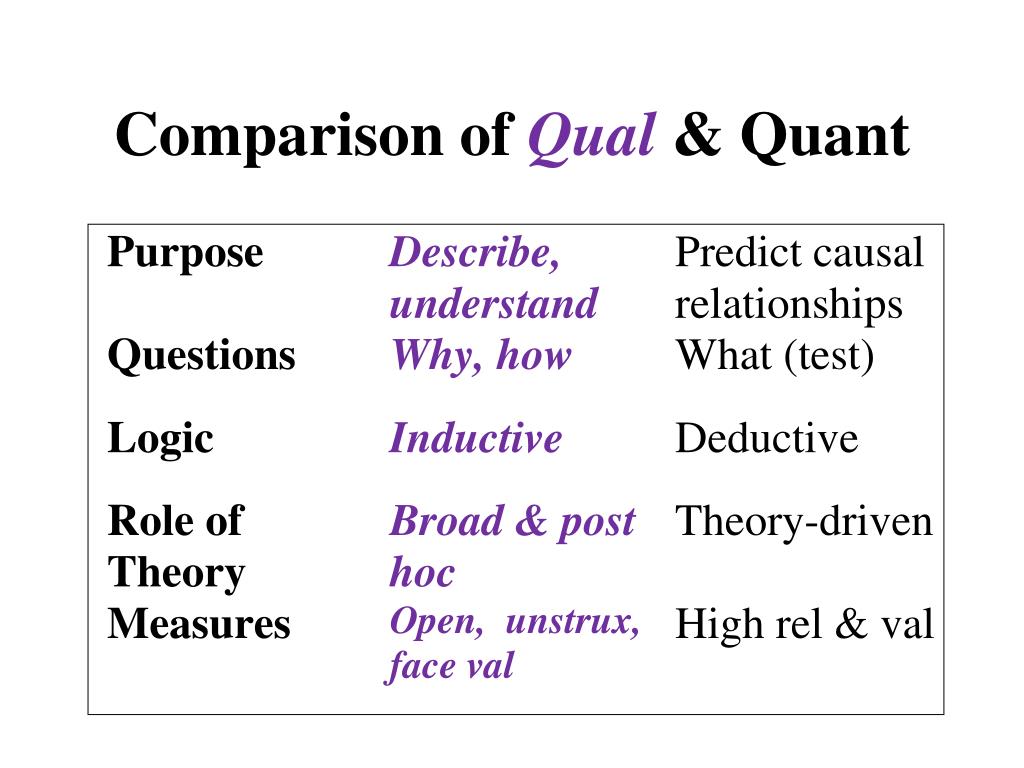

In a survey, you can ask both open-ended questions about “Why?” as well as closed-ended, data-related questions. You can even collect both quantitative and qualitative data within one type of research instrument. If you need both quantitative and qualitative data, then collect both. These question types will produce data that can be analyzed to find averages, ranges, growth rates, percentage changes, minimums/maximums, and even time-series data for longer-term trend analysis. You can ask many different types of questions that produce this quantitative data, including rating/ranking questions, single-select, multiselect, and matrix table questions.
#Qual vs quant software#
Quotes are a powerful tool for conveying sentiment and making a poignant point.įor quantitative data, you’ll end up with a data set that can be analyzed, often with statistical software such as Excel, R, or SPSS. This type of research is also great at producing quotes that can be used in presentations or reports. You’ll be reading through the data and looking for key themes that emerge over and over. Unsurprisingly, the two different approaches will generate different types of data that will need to be analyzed differently.įor qualitative data, you’ll end up with data that will be highly textual in nature. The best way to facilitate this type of research is through surveys or large-scale experiments. While not always necessary, sample sizes can sometimes be large enough to be statistically significant. A major benefit of the interview and focus group formats is the ability to ask follow-up questions and dig deeper on answers that are particularly insightful.Ĭonversely, quantitative research is designed for larger sample sizes, which can garner perspectives across a wide spectrum of respondents. The best way to facilitate this type of research is through one-on-one interviews, focus groups, and sometimes surveys. The goal is to understand “Why?” and the thinking behind the decisions.

Often, qualitative research is conducted with a small sample size and includes many open-ended questions. In the COVID example, you will need to know standard ranges of square footage and real-estate expenditures so that you can create answer options that will capture relevant, high-quality, and easily actionable data. You would also want to know the variability of those parameters. If your hypothesis is that COVID is going to transform the way companies think about office space, some of your parameters might include the percent of your workforce working from home pre- and post-COVID, total square footage of office space held, and/or real-estate spend expectations by executive leadership. In practice, the parameters are the factors you want to test against your hypothesis. This allows you to create a research outline that is controlled in all the ways that will produce high-quality data. Since quantitative research is highly structured, you first need to understand what the parameters are and how variable they are in practice. You need to have enough understanding about a topic in order to develop a hypothesis you can test. Qualitative research usually informs quantitative. Quantitative research is used to test or confirm a hypothesis. It allows you to get a baseline understanding of the topic and start to formulate hypotheses around correlation and causation. For this reason, qualitative research often comes prior to quantitative.

If you need deeper information about a topic you know little about, qualitative research can help you uncover themes. Qualitative research is used to formulate a hypothesis. They are opposite in their approach, which makes them balanced in their outcomes. The magnitude of each will depend on what you need to accomplish. Most research projects you undertake will likely require some combination of qualitative and quantitative data.
#Qual vs quant how to#
Quant - you’ve heard the terms before, but what do they mean? Here’s what you need to know on when to use them and how to apply them in your research projects.


 0 kommentar(er)
0 kommentar(er)
